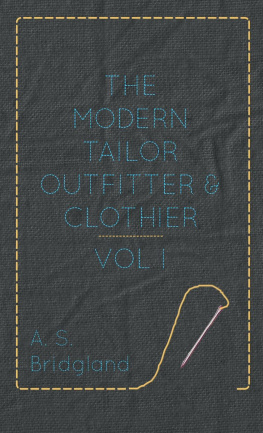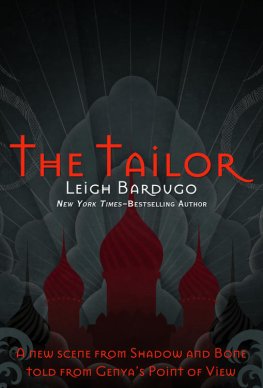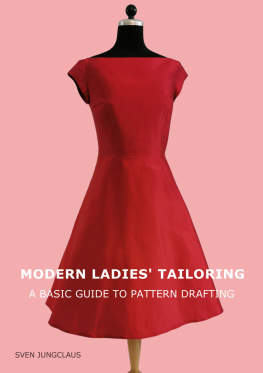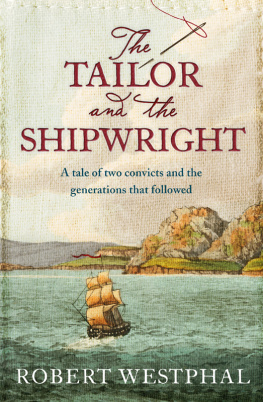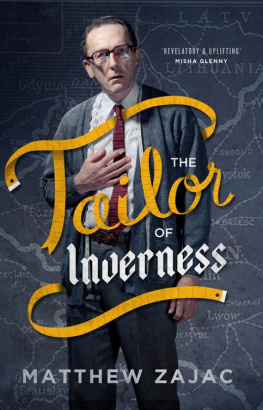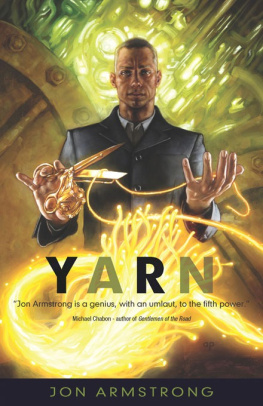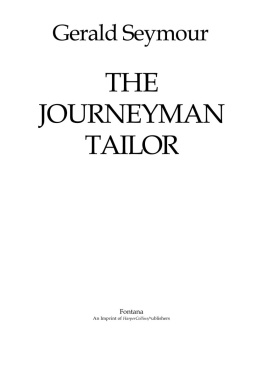The Modern Tailor Outfitter - The Modern Tailor Outfitter and Clothier, Volume I
Here you can read online The Modern Tailor Outfitter - The Modern Tailor Outfitter and Clothier, Volume I full text of the book (entire story) in english for free. Download pdf and epub, get meaning, cover and reviews about this ebook. year: 2017, publisher: Read Books Ltd., genre: Home and family. Description of the work, (preface) as well as reviews are available. Best literature library LitArk.com created for fans of good reading and offers a wide selection of genres:
Romance novel
Science fiction
Adventure
Detective
Science
History
Home and family
Prose
Art
Politics
Computer
Non-fiction
Religion
Business
Children
Humor
Choose a favorite category and find really read worthwhile books. Enjoy immersion in the world of imagination, feel the emotions of the characters or learn something new for yourself, make an fascinating discovery.
- Book:The Modern Tailor Outfitter and Clothier, Volume I
- Author:
- Publisher:Read Books Ltd.
- Genre:
- Year:2017
- Rating:3 / 5
- Favourites:Add to favourites
- Your mark:
- 60
- 1
- 2
- 3
- 4
- 5
The Modern Tailor Outfitter and Clothier, Volume I: summary, description and annotation
We offer to read an annotation, description, summary or preface (depends on what the author of the book "The Modern Tailor Outfitter and Clothier, Volume I" wrote himself). If you haven't found the necessary information about the book — write in the comments, we will try to find it.
The Modern Tailor Outfitter and Clothier, Volume I — read online for free the complete book (whole text) full work
Below is the text of the book, divided by pages. System saving the place of the last page read, allows you to conveniently read the book "The Modern Tailor Outfitter and Clothier, Volume I" online for free, without having to search again every time where you left off. Put a bookmark, and you can go to the page where you finished reading at any time.
Font size:
Interval:
Bookmark:

THE MODERN TAILOR OUTFITTER AND CLOTHIER
GENERAL EDITOR
A. S. BRIDGLAND, M.J.I.
EDITOR OF THE TAILOR AND CUTTER
VOLUME I
Copyright 2013 Read Books Ltd.
This book is copyright and may not be reproduced or copied in any way without the express permission of the publisher in writing
British Library Cataloguing-in-Publication Data
A catalogue record for this book is available from the British Library
Dressmaking and Tailoring
Dressmaking and Tailoring broadly refers to those who make, repair or alter clothing for a profession. A dressmaker will traditionally make custom clothing for women, ranging from dresses and blouses to full evening gowns (also historically called a mantua-maker or a modiste). Whereas a tailor will do the same, but usually for mens clothing - especially suits. The terms essentially refer to a specific set of hand and machine sewing skills, as well as pressing techniques that are unique to the construction of traditional clothing. This is separate to made to measure, which uses a set of preexisting patterns. Usually, a bespoke tailored suit or dress will be completely original and unique to the customer, and hence such items have been highly desirable since the trade first appeared in the thirteenth century. The Oxford English Dictionary states that the word tailor first came into usage around the 1290s, and undoubtedly by this point, tailoring guilds, as well as those of cloth merchants and weavers were well established across Europe.
As the tailoring profession has evolved, so too have the methods of tailoring. There are a number of distinctive business models which modern tailors may practice, such as local tailoring where the tailor is met locally, and the garment is produced locally too, distance tailoring, where a garment is ordered from an out-of-town tailor, enabling cheaper labour to be used - which, in practice can now be done on a global scale via e-commerce websites, and a travelling tailor, where the man or woman will travel between cities, usually stationing in a luxury hotel to provide the client the same tailoring services they would provide in their local store. These processes are the same for both womens and mens garment making.
Pattern making is a very important part of this profession; the construction of a paper or cardboard template from which the parts of a garment are traced onto fabric before cutting our and assembling. A custom dressmaker (or tailor) frequently employs one of three pattern creation methods; a flat-pattern method which begins with the creation of a sloper or block (a basic pattern for a garment, made to the wearers measurements), which can then be used to create patterns for many styles of garments, with varying necklines, sleeves, dart placements and so on. Although it is also used for womenswear, the drafting method is more commonly employed in menswear and involves drafting a pattern directly onto pattern paper using a variety of straightedges and curves. Since menswear rarely involves draping, pattern-making is the primary preparation for creating a cut-and-sew woven garment. The third method, the pattern draping method is used when the patternmakers skill is not matched with the difficulty of the design. It involves creating a muslin mock-up pattern, by pinning fabric directly on a dress form, then transferring the muslin outline and markings onto a paper pattern or using the muslin as the pattern itself.
Dressmaking and tailoring has become a very well respected profession; dressmakers such as Pierre Balmain, Christian Dior, Cristbal Balenciaga and Coco Chanel have gone on to achieve international acclaim and fashion notoriety. Balmain, known for sophistication and elegance, once said that dressmaking is the architecture of movement. Whilst tailors, due to the nature of their profession - catering to mens fashions, have not garnered such levels of individual fame, areas such as Savile Row in the United Kingdom are today seen as the heart of the trade.
THE MODERN TAILOR, OUTFITTER AND CLOTHIER
PLATE I

HENRY POOLE & CO., LTD., SAVILE ROW, LONDON, W.1.
PREFACE
N O attempt has hitherto been made to produce a work for the Tailoring Trade which could aspire to the scope and purpose of an encyclopdia. Such a project has only been rendered possible by the co-operation of men of diverse gifts and varied knowledge. In practically every case specialists asked to deal with a subject accepted the offer and gave of their best.
In undertaking a task of this nature, breadth of view was the main considerationthe Clothing Trade being looked upon as a whole. It was imperative to remember in such a survey that not only is there the high-class tailor conducting an exclusive trade, but the medium-class bespoke tailor whose work is also individual, and the colossal ready-to-wear or wholesale branch. A reasonable outlook shows these as parts of a great industry. Each can learn from the other : the bespoke trade teaching style and the wholesale trade methods of production.
The Editor is grateful to all those in every section of the trade who have collaborated with him and spared no pains to make the work a success. He would like to express thanks to Mr. William Cooling Lawrence for his wise and temperate introduction; to Mr. Frank Chitham for a candid and reasoned view of the future of the trade; to Messrs. Hawkes & Co. and Mr. Charles Howell for the loan of various illustrations; to Messrs. Dormeuil Frres for photographs; to Mr. J. D. Higgins for his views on trimmings; to various West End masters for drafts of fashionable garmentsindeed, to one and all who have contributed articles, drawn diagrams, or given permission to reproduce illustrations.
A. S. B.
CONTENTS
VOL. I
By WILLIAM COOLING LAWRENCE (President, Association of London Master Tailors, and Chairman, Joint Conciliation Board).
By F. CHITHAM (Director, Harrods, Ltd.).
By W. H. HULME (Head Teacher, Clothing Trades Department, Leeds Technical College).
By the EDITOR.
By PERCIVAL THICKETT (Author of Defects and Remedies, Body Coats, etc.).
By PERCIVAL THICKETT.
By the EDITOR.
By PERCIVAL THICKETT.
By PERCIVAL THICKETT.
By PERCIVAL THICKETT.
By PERCIVAL THICKETT.
By W. W. PIPER (Author of The Art of the Fitting-Room, Ladies Garments and How to Make Them, etc.).
By W. W. PIPER.
By W. W. PIPER.
By the EDITOR.
By the EDITOR.
By the EDITOR.
By PHILIP DELLAFERA.
By PHILIP DELLAFERA.
By PHILIP DELLAFERA.
By the EDITOR.
By J. T. ILEY (Author of Beginners First Course and How to Become a Ladies Tailor).
By PERCIVAL THICKETT.
By PHILIP DELLAFERA.
By H. A. ROGERS, J.P. (Director of John Walls Ltd., 106 Jermyn Street, London, W.1).
By D. W. LLOYD (Director of Teague Ltd., of Jermyn Street, London, W.1).
By J. W. LOVEGROVE (Honorary President, London Alliance of Master and Foremen Tailors; Prize Medallist, etc.).
LIST OF PLATES
VOL. I
THE MODERN TAILOR, OUTFITTER, AND CLOTHIER
VOL, I
INTRODUCTION
By WILLIAM COOLING LAWRENCE
(President, Association of London Master Tailors, and Chairman, Joint Conciliation Board)
I T is impossible within the limited space at my disposal to do more than sketch in brief outline my opinion of the importance and complexity of the Tailoring Industry.
In literature the genius of Carlyle has not disdained to speculate on the philosophy of clothes.
Next pageFont size:
Interval:
Bookmark:
Similar books «The Modern Tailor Outfitter and Clothier, Volume I»
Look at similar books to The Modern Tailor Outfitter and Clothier, Volume I. We have selected literature similar in name and meaning in the hope of providing readers with more options to find new, interesting, not yet read works.
Discussion, reviews of the book The Modern Tailor Outfitter and Clothier, Volume I and just readers' own opinions. Leave your comments, write what you think about the work, its meaning or the main characters. Specify what exactly you liked and what you didn't like, and why you think so.

